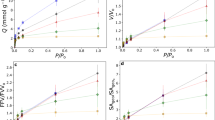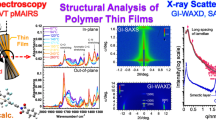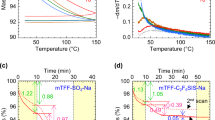Abstract
The extra free volume of glassy, highly permeable 1,2-disubstituted polyacetylenes is associated with the microporous organization of these polymers. In this work, the microporosity of poly(1-trimethylsilyl-1-propyne) (PTMSP) and poly(4-methyl-2-pentyne) (PMP) is investigated by two independent methods—convenient low-temperature Ar sorption and less commonly used small-angle X-ray scattering (SAXS). The Ar sorption data were analyzed in connection with the specific surface area, pore volume, and micropore size distribution. It is shown that the higher specific surface area, total pore volume, and micropore volume of PTMSP than those of PMP are associated with higher gas permeability coefficients. It was found that the Brunauer–Emmett–Teller-specific surface values obtained for PTMSP and PMP from argon sorption isotherms correlate with the specific surface values obtained from the SAXS method. The correlation of the specific surface values obtained from fundamentally different methods makes it possible to evaluate the small-angle scattering method as adequate for assessing the microporosity of polymeric materials.
This is a preview of subscription content, access via your institution
Access options
Subscribe to this journal
Receive 12 print issues and online access
$259.00 per year
only $21.58 per issue
Buy this article
- Purchase on Springer Link
- Instant access to full article PDF
Prices may be subject to local taxes which are calculated during checkout



Similar content being viewed by others
References
Nagai K, Masuda T, Nakagawa T, Freeman BD, Pinnau I. Poly [1-(trimethylsilyl)-1-propyne] and related polymers: synthesis, properties and functions. Prog Polym Sci. 2001;26:721–98.
Toy LG, Nagai K, Freeman BD, Pinnau I, He Z, Masuda T, et al. Pure-gas and vapor permeation and sorption properties of poly[1-phenyl-2-[p-(trimethylsilyl)phenyl]acetylene] (PTMSDPA). Macromolecules. 2000;33:2516–24.
Galizia M, Chi WS, Smith ZP, Merkel TC, Baker RW, Freeman BD. 50th anniversary perspective: polymers and mixed matrix membranes for gas and vapor separation: a review and prospective opportunities. Macromolecules. 2017;50:37809–43.
Hofmann D, Heuchel M, Yampolskii Yu, Khotimskii V, Shantarovich V. Free volume distributions in ultrahigh and lower free volume polymers: comparison between molecular modeling and positron lifetime studies. Macromolecules. 2002;25:2129–40.
Thomas S, Pinnau I, Du N, Guiver MD. Pure- and mixed-gas permeation properties of a microporous spirobisindane-based ladder polymer (PIM-1). J Membr Sci. 2009;333:125–31.
Staiger CI, Pas SJ, Hill AJ, Cornelius CJ. Gas separation, free volume distribution, and physical aging of a highly microporous spirobisindane polymer. Chem Mater. 2008;20:2606–8.
Rouquerol J, Avnir D, Fairbridge EW, Everett DH, Haynes JH, Pemicone N, et al. Recommendations for the characterization of porous solids (technical report). Pure Appl Chem. 1994;66:1739–58.
Cazorla-Amoros D, Alcaniz-Monje J, Linares-Solano A. Characterization of activated carbon fibers by CO2 adsorption. Langmuir. 1996;12:2820–4.
Dawson R, Cooper AI, Adams DJ. Nanoporous organic polymer networks. Prog Polym Sci. 2012;37:530–63.
Weber J, Schmidt J, Thomas A, Böhlmann W. Micropore analysis of polymer networks by gas sorption and 129Xe NMR spectroscopy: toward a better understanding of intrinsic microporosity. Langmuir. 2010;26:15650–6.
Palma-Condo A, Scherf U. Electrochemically generated thin films of microporous polymer networks: synthesis, properties, and applications. Macromol Chem Phys. 2016;217:827–41.
Cychosz KA, Guillet-Nicolas R, Garcia-Martinez J, Thommes M. Recent advances in the textural characterization of hierarchically structured nanoporous materials. Chem Soc Rev. 2017;46:389–414.
Kuwabara H, Suzuki T, Kaneko K. Ultramicropores in microporous carbon fibres evidenced by helium adsorption at 4.2 K. J Chem Soc Faraday Trans. 1991;87:1915–6.
Germain J, Svec F, Frechet JMJ. Preparation of size-selective nanoporous polymer networks of aromatic rings: potential adsorbents for hydrogen storage. Chem Mater. 2008;20:7069–76.
Weber J, Antonietti M, Thomas A. Microporous networks of high-performance polymers: elastic deformations and gas sorption properties. Macromolecules. 2008;41:2880–85.
Zakrzewski A, Zakrzewski M. Solid state characterization of pharmaceuticals. Danbury: Assa International; 2005.
Pikus S, Dawidowicz AL, Kobylas E, Wianowska D. Surface area investigation of materials with transition layers of continuously changing electron density. Appl Surf Sci. 1999;137:170–8.
Hu Y, Shiotsuki M, Sanda F, Freeman BD, Masuda T. Synthesis and properties of indan-based polyacetylenes that feature the highest gas permeability among all the existing polymers. Macromolecules. 2008;41:8525–32.
Litvinova EG, Melekhov VM, Petrushanskaya NV, Rosheva GV, Fedotov VB, Feldblum VS, et al. Pat 1823457 Russian Federation; 1993.
Surovtsev AA, Petrushanskaya NV, Karpov OP, Khotimskiy VS, Litvinova EG. Pat 2228323 Russian Federation; 2004.
Khotimsky VS, Tchirkova MV, Litvinova EG, Rebrov AI, Bondarenko GN. Poly [1‐(trimethylgermyl)‐1‐propyne] and poly [1‐(trimethylsilyl)‐1‐propyne] with various geometries: their synthesis and properties. J Polym Sci A Polym Chem. 2003;41:2133–55.
Matson SM, Makrushin VP, Levin IS, Zhilyaeva NA, Litvinova EG, Khotimskiy VS. Structure and properties of poly(4-methyl-2-pentyne) synthesized with NbBr5 and TaBr5-based catalytic systems. Polymer. 2020;202:122682.
Yave W, Peinemann KV, Shishatskiy S, Khotimskiy V, Chirkova M, Matson S, et al. Synthesis, characterization, and membrane properties of poly (1-trimethylgermyl-1-propyne) and its nanocomposite with TiO2. Macromolecules. 2007;40:8991–8.
Shcherbina MA, Chvalun SN, Ponomarenko SA, Kovalchuk MV. Modern approaches to the investigation of thin films and monolayers: X-ray reflectometry, grazing incidence scattering and X-ray standing wave method. Rus Chem Rev. 2014;83:1091–119.
Lowell S, Shields JE, Thomas MA, Thommes M. Characterization of porous solids and powders: surface area, pore size and area. New York: Springer Science & Business Media; 2004.
Thommes M, Cychosz KA. Physical adsorption characterization of nanoporous materials: progress and challenges. Adsorption. 2014;20:233–50.
Sing KSW, Everett DH, Haul RAW, Moscou L, Pierotti RA, Rouqerol J, et al. Reporting physisorption data for gas/solid systems with special reference to the determination of surface area and porosity. Pure Appl Chem. 1985;57:603–19.
Motahari A, Hu N, Vahid A, Omrani A, Rostami AA, Schaefer DW. Multilevel morphology of complex nanoporous materials. Langmuir. 2018;34:6719–26.
Acknowledgements
Synthesis of monomers and polymers, characterization of polymers, low-temperature sorption, and gas permeability experiments for this paper were financially supported by the Russian Science Foundation (Project No. 18–13–00334). The SAXS studies were carried out on the unique scientific equipment Kurchatov Synchrotron Radiation source of the National Research Center “Kurchatov Institute” under the program of providing services.
Author information
Authors and Affiliations
Corresponding author
Ethics declarations
Conflict of interest
The authors declare that they have no conflict of interest.
Additional information
Publisher’s note Springer Nature remains neutral with regard to jurisdictional claims in published maps and institutional affiliations.
Supplementary information
Rights and permissions
About this article
Cite this article
Matson, S.M., Zhilyaeva, N.A., Bakirov, A.V. et al. Investigation of the microporous organization of 1,2-disubstituted polyacetylenes using low-temperature argon sorption and small-angle X-ray scattering. Polym J 53, 449–454 (2021). https://doi.org/10.1038/s41428-020-00437-z
Received:
Revised:
Accepted:
Published:
Issue Date:
DOI: https://doi.org/10.1038/s41428-020-00437-z



